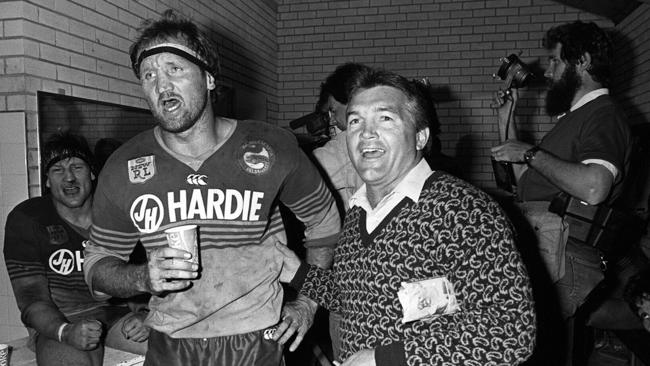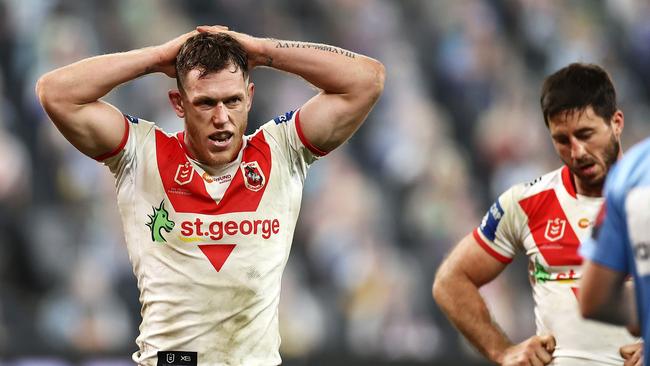NRL 2021: Who do you agree with in the fatigue debate?
The NRL says players are no more fatigued than normal – but the players wholeheartedly disagree. Who do you believe?

NRL
Don't miss out on the headlines from NRL. Followed categories will be added to My News.
Maybe it’s all their heads.
That appears to be the argument from the NRL after they revealed data shows players are no more fatigued now than before the league brought in their new controversial rules.
So who are we meant to believe?
Are we for the NRL and their data packs that seem to back everything they say up with the stats? Or are we against the NRL, instead backing the players who are actually out there and feeling the effects of the game?
Paul Crawley and Nick Walshaw do their best to argue both sides.

FOR THE NRL: Players should be grateful the league cares about them
— Paul Crawley
The Rugby League Players Association need to stop their whinging and start realising how lucky their members are to get paid a very generous salary to compete in a game where men of previous generations basically played for nothing, yet never complained half as much.
And to suggest the NRL was showing a lack of “awareness and respect for those playing the game” by releasing data that shows that the speed of the game has hardly changed during the last three years only highlights how much the modern generation seem to have lost sight of the reality of what the game is really trying to do with last weekend’s crackdown on high tackles.
Instead of complaining, the current generation should be extremely grateful that we have a governing body that is finally taking the incredibly delicate issue of concussion injuries seriously.
And for anyone to suggest the supposed increase in fatigue has led to more head high tackles is completely laughable, because fatigue has never been an excuse for careless or reckless behaviour.

I also find it incredibly insulting to past generations of footballers that the players of today seem to think their level of fatigue is anything greater than it was in previous eras.
Sure, the players today are no doubt bigger and stronger, fitter and faster than ever before.
But does anyone really believe they are busting their gut any more than blokes like Ray Price and Wayne Pearce did in their day, or back in the period of the game when there wasn’t even reserves let alone an interchange bench?
Seriously, rugby league players at the elite level have always aspired to push their bodies to breaking point and beyond.
And no one is probably better prepared to comment on it than Pearce, who is the ARL commissioner who came up with the idea to introduce the six again rule during the COVID shutdown last year.
The reason Pearce called for the change was because he was sick and tired of watching the game get bogged down by the wrestle.

And he should be congratulated for that because no one could surely argue the game is not a better spectacle now than it was during any period of the past decade when rugby league’s ‘wrestlemania’ was driving fans away in their droves.
Of course, Pearce was ahead of his time when it came to his fitness and endurance levels back in the 1980s.
And he was known not just for his explosive power but an ability to produce a match saving cover tackle in the dying minutes that made him one of the most inspirational of his time.
But even when he was completely out on his feet and his motor was running on empty, the one thing Pearce never did was take someone’s head off and try and blame it on the fact he was tired.
And he didn’t do that because Pearce not only had a wonderful tackling technique but he also played with tremendous discipline and respect for the laws of the game.
Maybe a few more players today could learn from that.
FOR THE PLAYERS: Selective data doesn’t tell the full story
APPARENTLY rugby league players aren’t getting any more fatigued now than in 2019, when a host of new rule changes were introduced to do exactly that.
Which will be welcome news for, say, Junior Paulo.
Same deal Dave Klemmer, Josh Papalii and Andrew Fifita.
Thought you’d never felt worse at the back end of games, boys?
Nup, you’re sweet.
We even have the numbers to prove it.
Just as League Central has, for years, also continually trotted out data to say bush footy is thriving – even as more clubs die.

Which may explain why late on Thursday afternoon, and shortly after the NRL went public with a host of figures proving, apparently, that players are no more fatigued now than 18 months ago, the RLPA started chasing data of its own.
Not because the NRL numbers are wrong.
Quite obviously, they aren’t.
But if you pick only a Fosters from all Australian beers, well, you’d hardly be convinced we know much about drinking, right?
Which is why the RLPA has started cold calling NRL clubs.
Aware that when it comes to those 480 constituents they routinely have out in the middle, overwhelmingly they feel more fatigued at the back end of games under these new rules.
Which they should.
For if not, why the bloody hell did we introduce them?
Indeed, no matter what anyone says now, you need only a quick Google search to know these rule changes were introduced to not only increase game speed, or decrease wrestle, but create fatigue among players late, allowing for little men to run riot.

You know, just like the good old days.
Of course, in the good old days, nobody cared when Barry Bopper threw out a lazy arm and decapitated the opposition’s halfback.
No, just let the kid pick up his teeth and carry on.
Which, of course, brings us to the real heartbeat of Thursday’s NRL announcement: Concussion.
Undoubtedly, the code is looking to create real change in the area of head knocks, for which it should be applauded.
With Peter V’landys, too, the robust leader this game has needed for years.
But if the NFL has taught us anything in its own ongoing, and costly, battle against concussion, it’s that more than actual player safety, there needs to be what Tim Layden referred to in a 2018 Sports Illustrated edition as perceived player safety.
Stating: “The NFL has succeeded, in some immeasurable degree, in using ‘safety initiatives’ to placate the head-trauma lobby which has a lot of science — and an increasing number of moms — on it’s side”.
Which brings us back to those numbers, released only days after the head body is said to have received a separate set of statistics from NRL clubs showing that players are now running faster, and at greater speeds. Which subsequently, is leading to more fatigue and an increased injury toll.
A theory several medical experts, including Dr Nathan Gibbs, support.
Which again, is why the RLPA is now chasing all sorts of numbers, measurements and data readings.
Not just the ones provided.
More Coverage
Originally published as NRL 2021: Who do you agree with in the fatigue debate?




